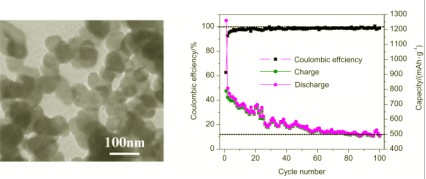| [1] Iijima, S. Nature 1991, 354, 56. [2] Alcántara, R.; Madrigal, F. J. F.; Lavela, P.; Tirado, J. L.; Mateos, J. M. J.; Salazar, C. G.; Stoyanova, R.; Zhecheva, E. Carbon 2000, 38, 1031. [3] Horri, B. A.; Selomulya, C.; Wang, H.-T. Int. J. Hydrogen Energy 2012, 37, 15311. [4] Li, Y.-H.; Huang, K.-L. Acta Chim. Sinica 2011, 69, 2185. (李艳华, 黄可龙, 化学学报, 2011, 69, 2185.) [5] Ito, Y.; Venkatesan, N.; Hirako, N.; Sugioka, N.; Takada, K. Int. J. Pharm. 2007, 337, 357. [6] Liu, Y.-C.; Qiu, X.-P.; Huang, Y.-Q.; Zhu, W.-T. Carbon 2002, 40, 2375. [7] Uchida, M.; Aoyama, Y.; Tanabe, N.; Yanagihara, N.; Eda, N.; Ohta, A. J. Electrochem. Soc. 1995, 142, 2572. [8] Dillon, A. C.; Jones, K. M.; Bekkedahl, T. A.; Kiang, C. H.; Bethune, D. S.; Heben, M. J. Nature 1997, 386, 377. [9] Jiang, J.-H.; Gao, Q.-M.; Zheng, Z.-J.; Xia, K.-S.; Hu, J. Int. J. Hydrogen Energy 2010, 35, 210. [10] Qiu, L.-B.; Sun, X.-M.; Yang, Z.-B.; Guo, W.-H.; Peng, H.-S. Acta Chim. Sinica 2012, 70, 1523. (丘龙斌, 孙雪梅, 仰志斌, 郭文瀚, 彭慧胜, 化学学报, 2012, 70, 1523.) [11] Xia, W.; Jin, C.; Kundu, S.; Muhler, M. Carbon 2009, 47, 919. [12] Qi, X.-S.; Zhong, W.; Yao, X.-J.; Zhang, H.; Ding, Q.; Wu, Q.; Deng, Y.; Au, C.; Du, Y. Carbon 2012, 50, 646. [13] Mondal, K. C.; Strydom, A. M.; Tetana, Z.; Mhlanga, S. D.; Witcomb, M. J.; Havel, J.; Erasmus, R. M.; Coville, N. J. Mater. Chem. Phys. 2009, 114, 973. [14] Yang, Y.-Z.; Liu, X.-G.; Xu, B.-S.; Li, T.-B. Carbon 2006, 44, 1661. [15] Moothi, K.; Iyuke, S. E.; Meyyappa, M.; Falcon, R. Carbon 2012, 50, 2679. [16] Corthals, S.; Noyen, J. V.; Geboers, J.; Vosch, T.; Liang, D.-D.; Ke, X.-X.; Hofkens, J.; Tendeloo, G. V.; Jacobs, P.; Sels, B. Carbon 2012, 50, 372. [17] Jin, Y.-Z.; Gao, C.; Hsu, W. K.; Zhu, Y.-Q.; Huczko, A.; Bystrzejewski, M.; Roe, M.; Lee, C. Y.; Acquah, S.; Kroto, H.; Walton, D. R. M. Carbon 2005, 43, 1944. [18] Moothi, K.; Iyuke, S. E.; Meyyappan, M.; Falcon, R. Carbon 2012, 50, 2679. [19] Zhang, Y.-P. Ph.D. Dissertation, Dalian University of Technology, Dalian, 2004. (张云鹏, 博士论文, 大连理工大学, 大连, 2004.) [20] Yang, Y.-Z.; Liu, X.-G.; Jia, H.-S.; Xu, B.-S. Mater. Chem. Phys. 2011, 126, 424. [21] Liu, X.-G.; Yang, Y.-Z.; Lin, X.; Xu, B.-S.; Zhang, Y. Fuel Process. Technol. 2006, 87, 919. [22] Yang, Y.-Z.; Liu, X.-G.; Luo, Q.-P.; Jin, L.; Xu, B.-S. New Carbon Mater. 2010, 25, 431. [23] Li, F.-H.; Shen, Z.-M.; Xue, R.-S.; Chi, W.-D. New Carbon Mater. 2004, 19, 21. (李伏虎, 沈曾民, 薛锐生, 迟伟东, 新型碳材料, 2004, 19, 21.) [24] Yang, Y.-Z.; Liu, X.-G.; Zhang, C.-Y.; Guo, M.-C.; Xu, B.-S. J. Phys. Chem. Solids 2010, 71, 235. [25] Duan, L.-H.; Huang, Y.-D.; Jia, D.-Z.; Wang, X.-C.; Guo, Z.-P.Mater. Lett. 2012, 71, 151. |
